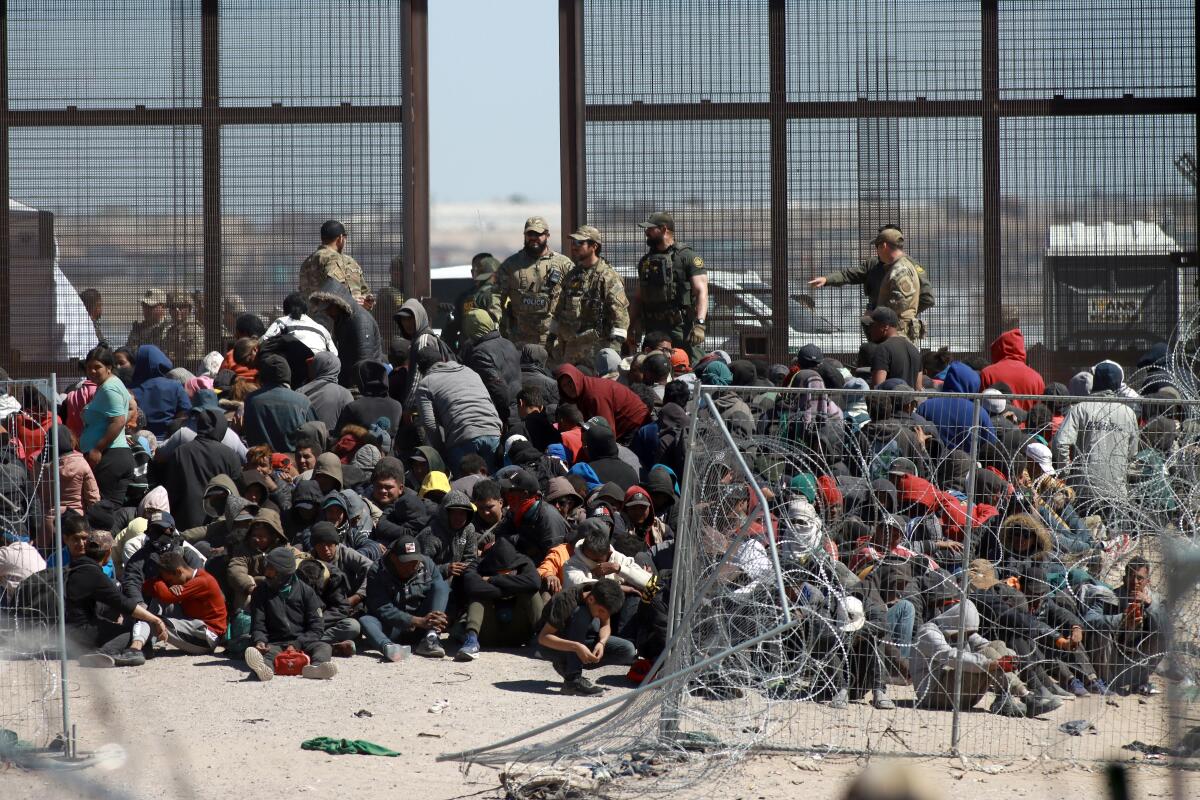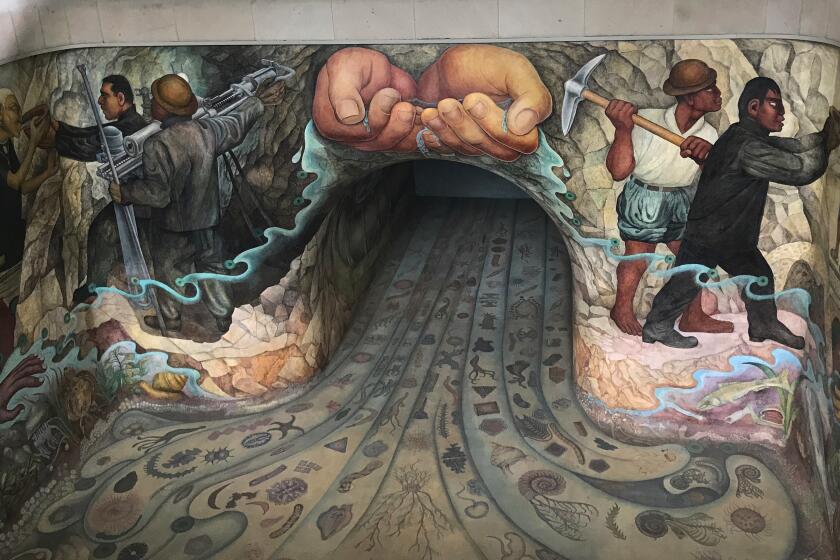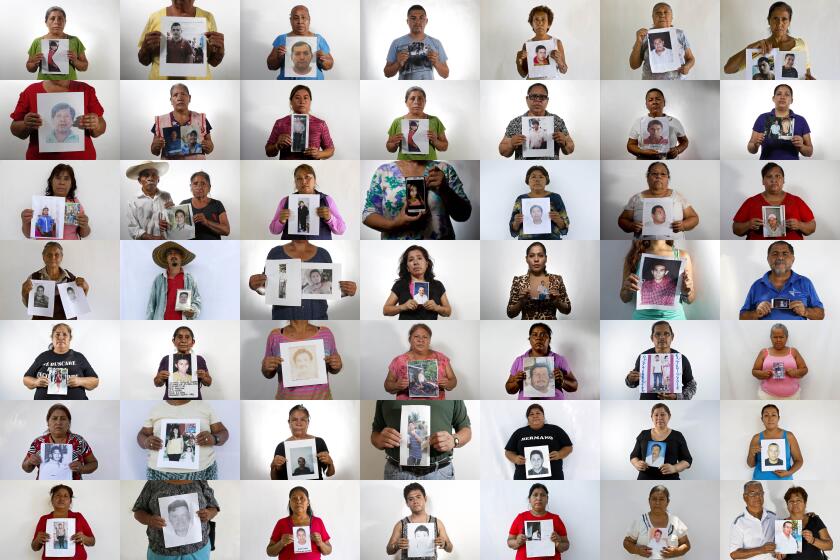The standoff at Gate 36: Texas sends in the troops to block migrants from seeking asylum

- Share via
CIUDAD JUAREZ, Mexico — There was a time when migrants arriving here would cross the Rio Grande, make their way to a gate in the border fence and turn themselves in to federal agents to claim asylum.
That was before Texas Gov. Greg Abbott turned Gate 36 into a militarized zone, fortified by rifle-toting soldiers, a fleet of Humvees and a forest of razor wire glistening in the desert sun.
“It looks like a prison,” Mario Jesús Nazareño said Saturday afternoon, gazing north across the river.
The 47-year-old former boxer had just arrived at the border after traveling for weeks from his native Ecuador. He hoped to make his way to Florida, where he has relatives.
Now he and hundreds of others were stuck. The governor’s aim is to prevent migrants from reaching the gate — part of the 30-foot-high, steel border wall built during the Trump presidency — and thus deny them a chance to apply for political asylum or other forms of relief that could allow them to remain in the United States.

“All we want to do is give ourselves up,” said David Arau, 33, who traveled for months from his home in northern Venezuela. “But the army won’t let us.”
It was yet another day in the standoff at Gate 36.
The challenge in Mexico City, built amid lakes by the Aztecs, had long been getting rid of water, not storing it. Now its taps are running dry.
Immigration enforcement has long been the domain of the federal government. But Texas is challenging that at a time when record numbers of migrants are arriving at the U.S. southern border.
Abbott has been amping up “Operation Lone Star,” the crackdown he launched three years ago using National Guard troops and state police to deter illegal immigration and narcotics smuggling — and draw attention to what he argues is the Biden administration’s failure to control the border.
The Texas governor has been trying to enact a statute passed last year known as Senate Bill 4 that would allow state and local authorities to arrest migrants simply for being in the country illegally. The 5th Circuit Court of Appeals, which put a temporary hold on SB 4 last week, is scheduled to hear arguments in the case early next month.
The White House considers the statute an unconstitutional infringement on federal authority — an argument that many expect to wind up before the Supreme Court.
That legal battle is playing out at a moment when the border has emerged as a major campaign issue in this national election year.
For evidence of Abbott’s intensifying get-tough tactics, look no further than Gate 36, where Abbott first deployed National Guard soldiers and state police in late 2022.
Critics say the government of Mexican President Andrés Manuel López Obrador is trying to downplay how people have disappeared in recent years.

Last week, after scores of migrants clashed with Texas troops, broke through the militarized zone at Gate 36 and surrendered to the Border Patrol, Abbott declared that his units had sealed the breach.
“The TX National Guard & Dept. of Public Safety quickly regained control & are redoubling the razor wire barriers,” Abbott wrote on X, formerly Twitter. “DPS is instructed to arrest every illegal immigrant involved for criminal trespass & destruction of property.”
Soon, a reinforced phalanx of troops in riot helmets was staring down a bedraggled array of border crossers living in an encampment on the trash-strewn U.S. bank of the Rio Grande, barely a trickle at times. Scores of makeshift tents — mostly blankets and sheets strung from wood poles — stretch for several hundred yards between the water and the razor wire.
A few yards away, heavy construction equipment pushed new sections of fencing into place. A recorded voice from a megaphone warned migrants that they could be arrested for damaging the razor wire.
Despite the tensions between the Biden administration and the Texas governor’s office, Border Patrol officials said federal and state authorities coordinate closely at Gate 36 and other areas. “Obviously Operation Lone Star is a state initiative, not a federal one, but we are there and we cooperate,” said one Border Patrol official who was not authorized to speak publicly.
Many of the migrants have traveled for months from South America and beyond, crossing oceans, jungles, mountains, cities and deserts in a transcontinental odyssey. Some heard of Gate 36 long before arriving here.
Migrants come and go at the camp, leaving behind the artifacts of their existence: a toothbrush, a pair of spectacles, a washed-out identification card, a handwritten letter, shreds of clothing clinging to barbed wire and bushes like tattered Christmas ornaments.
There are no toilets or clean water. Migrants sprint across a six-lane highway to buy food, water and other necessities at an Oxxo convenience store.
“I never imagined that this place would be so horrible,” said Lisbeth Carrillo, 31, who was traveling with her daughters, María, 15, and Cirielis, 5 — two of the many children in the camp.
“But we’re going to wait until we can get across,” said Carrillo, who ran a beauty shop back in Venezuela.
She and her girls hiked through the jungle wilderness known as the Darién Gap between Colombia and Panama. But she and others said the most difficult part of the 3,000-mile journey from Venezuela was the route through Mexico — where migrants confront corrupt cops, common thieves, cartel thugs and Mexican immigration agents who detain them and often ship them back to southern Mexico.
“The Darién is difficult, but nothing like Mexico,” said Carrillo, whose black shirt was torn in the back from an unsuccessful effort to crawl through Texas’ razor wire barrier. “In Mexico, anything can happen.”
The muxe — Indigenous Zapotec people in Mexico — view themselves as neither man nor woman. They embrace a distinct ‘third gender,’ part of a burgeoning LGBTQ+ movement worldwide.
In January, migrant detentions fell by about half in several key crossing zones in Texas, while rising significantly in the San Diego and Tucson areas — a shift for which Abbott has claimed credit.
“Our stiff resistance is working,” the governor wrote last month on X. “Texas will continue to hold the line.”
But experts say it is too early to explain that change in migration patterns. Migrants routinely exchange information via group chats about revisions in U.S. tactics. Past crackdowns have prompted shifts to ever more-remote parts of the border. That, in turn, has often led to increased migrant deaths in deserts, mountains and other isolated zones.
More than 73,000 people crossed the Darién Gap in the first two months of 2024, nearly 50% more than in the same period last year, when a record more than half a million people made the northbound journey, according to Panamanian officials, who say almost all were headed for the United States.
Many, if not most, migrants arriving at the U.S. border plan to file for political asylum — though large numbers acknowledge they are seeking economic betterment, not fleeing persecution. Immigration courts are so severely backlogged that asylum seekers are routinely being let into the country while they await court dates more than two years away.
With migration showing no sign of relenting, the standoff at Gate 36 seems destined to continue.
The son of slain presidential candidate Luis Donaldo Colosio asked that his killer be pardoned, but President Andrés Manuel López Obrador refused.
Early Sunday, as a dust storm enveloped the area, several hundred migrants managed to escape the camp, crawling under the coils of razor wire or cutting through them and running about 50 yards to the steel wall, where Border Patrol agents were waiting.
As they lined up later along the border fence, their places in the camp were soon taken by fresh arrivals who had hitched rides on freight trains to make it to Ciudad Juárez. The newcomers quickly claimed abandoned tents and blankets.
“One thing is sure: We have come this far, we can’t go back to Venezuela,” said Yender Arrieta, 26, who had been on the road for two months. “We will get across eventually.”
Nodding in agreement were his sister, three nephews, an uncle and an aunt, all huddled under blankets as a fierce wind blew a blinding dust.
Special correspondent Gabriela Minjares contributed to this report.
More to Read
Sign up for Essential California
The most important California stories and recommendations in your inbox every morning.
You may occasionally receive promotional content from the Los Angeles Times.














